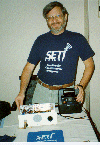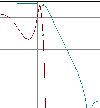|
After the low-pass filter, the audio is applied to a low-noise preamplifier, which drives an audio power amplifier through a simple third-order Butterworth high-pass filter. We double the value of the two series capacitors, to slightly lower cutoff frequency while retaining reasonable 60 Hz hum rejection. In all, adapting the R2 to SETI use has required the substitution of 14 capacitors, 7 fixed inductors, and 6 resistors. The new component values are seen at the top of the diagram (component designations are per the schematic in the original QST article). Kanga US will be offering a commercial version of the R2 receiver kit, incorporating these modifications, for SETI use.
| | SETI League drawing |
|
 |












 SETI League Photo Gallery
SETI League Photo Gallery










